The Lively Blog
SIGN UP FOR OUR
Newsletter
Stay up to date on the latest news delivered straight to your inbox
2018 HSA Spend Report
Lively · February 6, 2019 · 2 min read

You know the narrative — healthcare is expensive. Healthcare spending is up year-over-year (3.9%), with costs rising faster than the annual rate of inflation. This, combined with the rise of high deductible health plans (HDHPs), puts pressure on the average American consumer to spend more of their savings on everyday health expenses.
What this conversation is missing is what and where Americans are spending this money. Are expenses dominated by high-cost medical events, like hospital stays? Or is it the combined effect of higher co-pays and out-of-pocket costs for health services and prescriptions?
Lively sampled HSA spend data from thousands of random, unique customers to better understand consumer habits when it comes to healthcare spending. This HSA Spend Report will outline where consumers spend their HSA funds and compare that against data from the Center for Medicare and Medicaid Services to understand the similarities and differences between HSA spending and national healthcare spending.
2018 HSA Spend Report
Report Details: Lively collected anonymous data from a randomly selected subset of users (15,000), who had an HSA account in 2018. This includes accounts with active contributions and ones without. To classify the types of health goods or services that were provided, HSA debit card spend data from January to December 2018 was categorized with Merchant Category Codes (MCCs). No demographic or personal information was provided or used to create these cohorts. As such, any demographic details are based on post-data collection analysis.
**
2018 HSA Spend Report
**
Key Findings
HSA funds are primarily being used to pay for rising household healthcare expenses.
Personal household out-of-pocket healthcare expenses continue to increase and outpace inflation, causing these costs to grow each year as a percentage share of personal household expenses (37%).
Short-term costs limit long-term benefits.
While HSAs have clear short and long-term tax advantages, rising healthcare costs are forcing HSA account holders to use more of their funds for expected expenses each year, rather than saving and investing them for later use.
Where did the money go?
Physician and clinical services were the primary use of HSA funds in 2018 (41 percent), followed by prescription drugs (25 percent), then hospital expenses (7 percent).
**
Download the HSA Report here
**
Things like your flexibility in contributing, the ability to keep your unused balance and additional tax benefits make HSAs the wisest choice. So sign up for an HSA – it’s free →

Benefits
2023 and 2024 HSA Maximum Contribution Limits
Lively · May 16, 2023 · 3 min read
On May 16, 2023 the Internal Revenue Service announced the HSA contribution limits for 2024. For 2024 HSA-eligible account holders are allowed to contribute: $4,150 for individual coverage and $8,300 for family coverage. If you are 55 years or older, you’re still eligible to contribute an extra $1,000 catch-up contribution.

Benefits
What is the Difference Between a Flexible Spending Account and a Health Savings Account?
Lauren Hargrave · February 9, 2024 · 12 min read
A Health Savings Account (HSA) and Healthcare Flexible Spending Account (FSA) provide up to 30% savings on out-of-pocket healthcare expenses. That’s good news. Except you can’t contribute to an HSA and Healthcare FSA at the same time. So what if your employer offers both benefits? How do you choose which account type is best for you? Let’s explore the advantages of each to help you decide which wins in HSA vs FSA.

Health Savings Accounts
Ways Health Savings Account Matching Benefits Employers
Lauren Hargrave · October 13, 2023 · 7 min read
Employers need employees to adopt and engage with their benefits and one way to encourage employees to adopt and contribute to (i.e. engage with) an HSA, is for employers to match employees’ contributions.
SIGN UP FOR OUR
Newsletter
Stay up to date on the latest news delivered straight to your inbox
